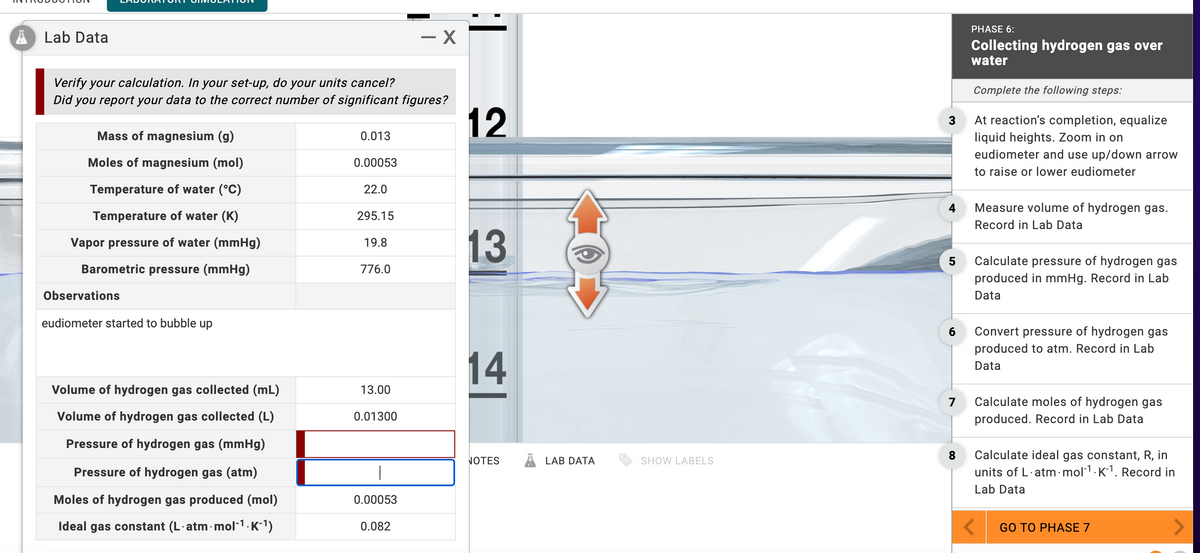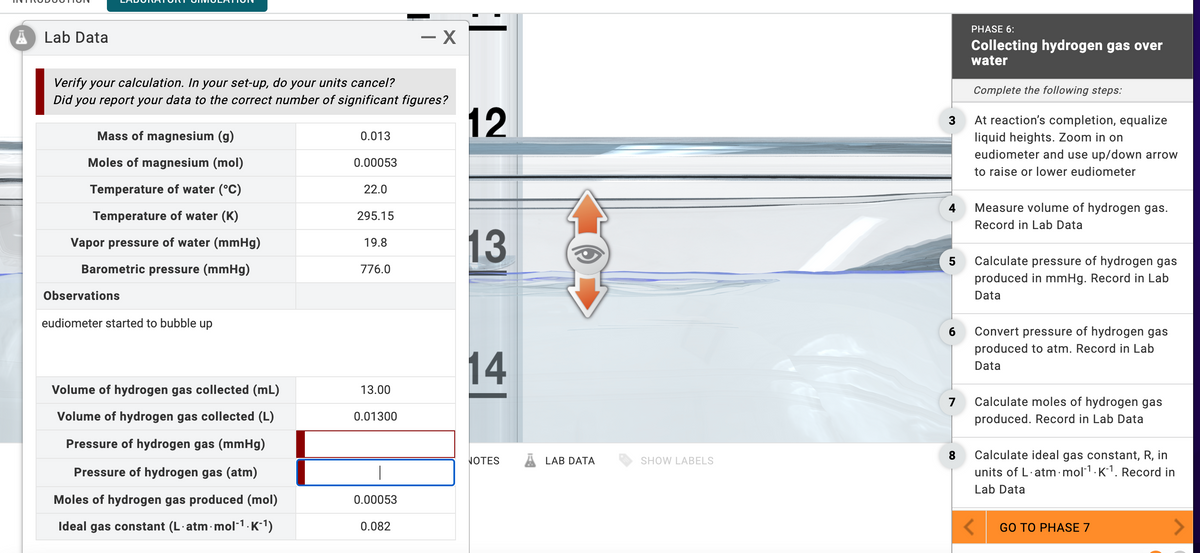Verify your calculation. In your set-up, do your units cancel? Did you report your data to the correct number of significant figures? Mass of magnesium (g) Moles of magnesium (mol) Temperature of water (°C) Temperature of water (K) Vapor pressure of water (mmHg) Barometric pressure (mmHg) Observations eudiometer started to bubble up Volume of hydrogen gas collected (mL) Volume of hydrogen gas collected (L) Pressure of hydrogen gas (mmHg) Pressure of hydrogen gas (atm) Moles of hydrogen gas produced (mol) Ideal gas constant (L-atm-mol-¹-K-¹) 0.013 0.00053 22.0 295.15 19.8 776.0 13.00 0.01300 I 0.00053 0.082
Verify your calculation. In your set-up, do your units cancel? Did you report your data to the correct number of significant figures? Mass of magnesium (g) Moles of magnesium (mol) Temperature of water (°C) Temperature of water (K) Vapor pressure of water (mmHg) Barometric pressure (mmHg) Observations eudiometer started to bubble up Volume of hydrogen gas collected (mL) Volume of hydrogen gas collected (L) Pressure of hydrogen gas (mmHg) Pressure of hydrogen gas (atm) Moles of hydrogen gas produced (mol) Ideal gas constant (L-atm-mol-¹-K-¹) 0.013 0.00053 22.0 295.15 19.8 776.0 13.00 0.01300 I 0.00053 0.082
Chemistry
10th Edition
ISBN:9781305957404
Author:Steven S. Zumdahl, Susan A. Zumdahl, Donald J. DeCoste
Publisher:Steven S. Zumdahl, Susan A. Zumdahl, Donald J. DeCoste
Chapter1: Chemical Foundations
Section: Chapter Questions
Problem 1RQ: Define and explain the differences between the following terms. a. law and theory b. theory and...
Related questions
Question
need to find the Pressure of hydrogen gas (mmHg) and the Pressure of hydrogen gas (atm)
(the answer is NOT Pressure of hydrogen gas = 0.9867atm or 749.89mm Hg.)

Transcribed Image Text:A
Lab Data
Verify your calculation. In your set-up, do your units cancel?
Did you report your data to the correct number of significant figures?
Mass of magnesium (g)
Moles of magnesium (mol)
Temperature of water (°C)
Temperature of water (K)
Vapor pressure of water (mmHg)
Barometric pressure (mmHg)
Observations
eudiometer started to bubble up
Volume of hydrogen gas collected (mL)
Volume of hydrogen gas collected (L)
Pressure of hydrogen gas (mmHg)
Pressure of hydrogen gas (atm)
Moles of hydrogen gas produced (mol)
Ideal gas constant (L·atm·mol-¹.K-¹)
0.013
0.00053
22.0
295.15
19.8
776.0
13.00
0.01300
- X
|
0.00053
0.082
12
13
14
|
NOTES
LAB DATA
SHOW LABELS
3
4
5
6
7
8
PHASE 6:
Collecting hydrogen gas over
water
Complete the following steps:
At reaction's completion, equalize
liquid heights. Zoom in on
eudiometer and use up/down arrow
to raise or lower eudiometer
Measure volume of hydrogen gas.
Record in Lab Data
Calculate pressure of hydrogen gas
produced in mmHg. Record in Lab
Data
Convert pressure of hydrogen gas
produced to atm. Record in Lab
Data
Calculate moles of hydrogen gas
produced. Record in Lab Data
Calculate ideal gas constant, R, in
units of L.atm.mol-¹ K-¹. Record in
Lab Data
<
GO TO PHASE 7
>

Transcribed Image Text:A
Lab Data
Verify your calculation. In your set-up, do your units cancel?
Did you report your data to the correct number of significant figures?
Mass of magnesium (g)
Moles of magnesium (mol)
Temperature of water (°C)
Temperature of water (K)
Vapor pressure of water (mmHg)
Barometric pressure (mmHg)
Observations
eudiometer started to bubble up
Volume of hydrogen gas collected (mL)
Volume of hydrogen gas collected (L)
Pressure of hydrogen gas (mmHg)
Pressure of hydrogen gas (atm)
Moles of hydrogen gas produced (mol)
Ideal gas constant (L·atm·mol-¹.K-¹)
0.013
0.00053
22.0
295.15
19.8
776.0
13.00
0.01300
- X
|
0.00053
0.082
12
13
14
|
NOTES
LAB DATA
SHOW LABELS
3
4
5
6
7
8
PHASE 6:
Collecting hydrogen gas over
water
Complete the following steps:
At reaction's completion, equalize
liquid heights. Zoom in on
eudiometer and use up/down arrow
to raise or lower eudiometer
Measure volume of hydrogen gas.
Record in Lab Data
Calculate pressure of hydrogen gas
produced in mmHg. Record in Lab
Data
Convert pressure of hydrogen gas
produced to atm. Record in Lab
Data
Calculate moles of hydrogen gas
produced. Record in Lab Data
Calculate ideal gas constant, R, in
units of L.atm.mol-¹ K-¹. Record in
Lab Data
<
GO TO PHASE 7
>
Expert Solution
This question has been solved!
Explore an expertly crafted, step-by-step solution for a thorough understanding of key concepts.
Step by step
Solved in 2 steps

Knowledge Booster
Learn more about
Need a deep-dive on the concept behind this application? Look no further. Learn more about this topic, chemistry and related others by exploring similar questions and additional content below.Recommended textbooks for you

Chemistry
Chemistry
ISBN:
9781305957404
Author:
Steven S. Zumdahl, Susan A. Zumdahl, Donald J. DeCoste
Publisher:
Cengage Learning

Chemistry
Chemistry
ISBN:
9781259911156
Author:
Raymond Chang Dr., Jason Overby Professor
Publisher:
McGraw-Hill Education

Principles of Instrumental Analysis
Chemistry
ISBN:
9781305577213
Author:
Douglas A. Skoog, F. James Holler, Stanley R. Crouch
Publisher:
Cengage Learning

Chemistry
Chemistry
ISBN:
9781305957404
Author:
Steven S. Zumdahl, Susan A. Zumdahl, Donald J. DeCoste
Publisher:
Cengage Learning

Chemistry
Chemistry
ISBN:
9781259911156
Author:
Raymond Chang Dr., Jason Overby Professor
Publisher:
McGraw-Hill Education

Principles of Instrumental Analysis
Chemistry
ISBN:
9781305577213
Author:
Douglas A. Skoog, F. James Holler, Stanley R. Crouch
Publisher:
Cengage Learning

Organic Chemistry
Chemistry
ISBN:
9780078021558
Author:
Janice Gorzynski Smith Dr.
Publisher:
McGraw-Hill Education

Chemistry: Principles and Reactions
Chemistry
ISBN:
9781305079373
Author:
William L. Masterton, Cecile N. Hurley
Publisher:
Cengage Learning

Elementary Principles of Chemical Processes, Bind…
Chemistry
ISBN:
9781118431221
Author:
Richard M. Felder, Ronald W. Rousseau, Lisa G. Bullard
Publisher:
WILEY